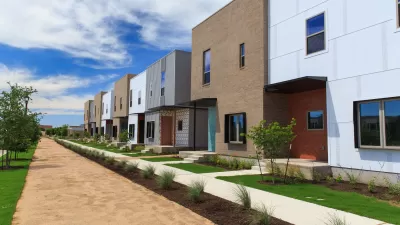How the tension between housing as an asset and as an essential good keeps the supply inadequate and costs high.

Using Austin, Texas as an example, Derek Thompson explains America’s ‘magical thinking’ about housing in an article for The Atlantic.
According to Thompson, “Since the beginning of the pandemic, even as rent inflation has gone berserk nationwide, no city has experienced anything like Austin’s growth in housing costs. In 2021, rents rose at the most furious annual rate in the city’s history. In 2022, rent growth exceeded every other large city in the country, as Austin’s median rent nearly doubled.”
Unlike many other cities, Thompson writes, Austin “experimented with the uncommon strategy of actually building enough homes for people to live in. This year, Austin is expected to add more apartment units as a share of its existing inventory than any other city in the country.”
This is, unequivocally, a good thing. But an article in The Wall Street Journal takes an alarming tone, calling the resulting drop in rent prices a ‘downswing.’
“If rising rent prices are bad, but falling rent prices are also bad, what exactly are we supposed to root for in the U.S. housing market?” Thompson asks. This may depend on whether you view housing as an investment and an asset or an essential good and human right. For Thompson, “Housing is, in fact, both a present need and a future investment. In a dual-side marketplace, I suppose you could argue that any change in price is bad for some party. But the externalities of housing abundance outweigh the loss to any particular party rooting to profit from scarcity.”
FULL STORY: America’s Magical Thinking About Housing

Alabama: Trump Terminates Settlements for Black Communities Harmed By Raw Sewage
Trump deemed the landmark civil rights agreement “illegal DEI and environmental justice policy.”

Planetizen Federal Action Tracker
A weekly monitor of how Trump’s orders and actions are impacting planners and planning in America.

The 120 Year Old Tiny Home Villages That Sheltered San Francisco’s Earthquake Refugees
More than a century ago, San Francisco mobilized to house thousands of residents displaced by the 1906 earthquake. Could their strategy offer a model for the present?

In Both Crashes and Crime, Public Transportation is Far Safer than Driving
Contrary to popular assumptions, public transportation has far lower crash and crime rates than automobile travel. For safer communities, improve and encourage transit travel.

Report: Zoning Reforms Should Complement Nashville’s Ambitious Transit Plan
Without reform, restrictive zoning codes will limit the impact of the city’s planned transit expansion and could exclude some of the residents who depend on transit the most.

Judge Orders Release of Frozen IRA, IIJA Funding
The decision is a victory for environmental groups who charged that freezing funds for critical infrastructure and disaster response programs caused “real and irreparable harm” to communities.
Urban Design for Planners 1: Software Tools
This six-course series explores essential urban design concepts using open source software and equips planners with the tools they need to participate fully in the urban design process.
Planning for Universal Design
Learn the tools for implementing Universal Design in planning regulations.
Clanton & Associates, Inc.
Jessamine County Fiscal Court
Institute for Housing and Urban Development Studies (IHS)
City of Grandview
Harvard GSD Executive Education
Toledo-Lucas County Plan Commissions
Salt Lake City
NYU Wagner Graduate School of Public Service





























